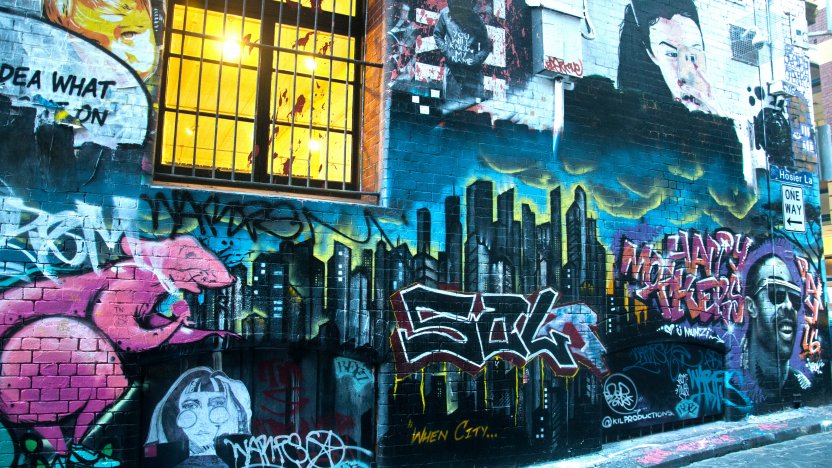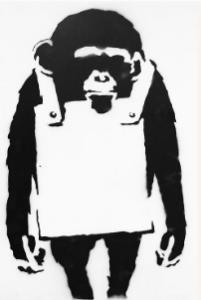No monkey business: Banksy trademark not filed in bad faith

EUIPO's Cancellation Division declared the trademark registration for Banksy's Monkey image invalid on the grounds of bad faith in spring 2021. In October 2022, that Banksy trademark decision was overturned based both on the absence of bad faith and the image’s distinctiveness, as Rosan Slits explains.
 When you think about anonymous British street art, Banksy is invariably the first name to come to mind. This influential activist artist makes his artworks available for free download online, but with an explicit exception for commercial purposes.
When you think about anonymous British street art, Banksy is invariably the first name to come to mind. This influential activist artist makes his artworks available for free download online, but with an explicit exception for commercial purposes.
While Banksy famously said that “copyright is for losers”, he is increasingly turning to IP to block commercial use, establishing the Pest Control Office in 2009 to authenticate artwork and register European trademark (EUTM) rights to the images. His desire to remain anonymous adds an additional challenge to IP registration and enforcement however.
Banksy trademark dispute: Is graffiti fair game?
We previously covered the trademark dispute between Banksy and UK greeting card company Full Colour Black, which had reproduced some of Banksy’s famous artworks on its range of greetings cards without his authorisation.
While the Pest Control Office had filed 15 EUTMs to protect certain Banksy artworks, seven of those registrations were subject to invalidity actions. One of the cases was suspended, but the remaining six registrations were overturned by the EUIPO’s Cancellation Division on the grounds that Banksy never intended to actually use the sign as a trademark. Rather, the purpose of the registration was to circumvent copyright restrictions to prevent others from using the sign, hence the finding of ‘bad faith’.
 In particular, the opening of ‘Gross Domestic Product’ in 2019, a showroom featuring Banksy merchandise (see image right), was taken as an acknowledgement that the artist did not actually intend to use the artwork as an origin mark. Banksy's statement "copyright is for losers" further suggested that anything depicted in public could be used freely by anyone without permission. Finally, Full Colour Black argued that Banksy’s artwork was already widely used in commerce and that Banksy had not done anything to prevent this from happening.
In particular, the opening of ‘Gross Domestic Product’ in 2019, a showroom featuring Banksy merchandise (see image right), was taken as an acknowledgement that the artist did not actually intend to use the artwork as an origin mark. Banksy's statement "copyright is for losers" further suggested that anything depicted in public could be used freely by anyone without permission. Finally, Full Colour Black argued that Banksy’s artwork was already widely used in commerce and that Banksy had not done anything to prevent this from happening.
The Pest Control Office has now contested the first of these cancellation rulings successfully.
Bad faith under EU trademark law
Following the ruling in Lindt & Sprüngli v Hauswirth, the Court of Justice of the European Union (CJEU) gave further interpretation to the concept of bad faith in both the Koton and Sky v Skykick judgements. The Court held in Koton that a trademark is filed in bad faith when relevant and consistent evidence shows that the applicant did not file the application in order to participate fairly in competition. Instead, there is an intent to prejudice the interests of third parties in a manner inconsistent with fair practice or to obtain an exclusive right for purposes other than those covered by the functions of a trademark (in particular indication of origin).
In Sky v Skykick, the CJEU considered (in line with Koton) that an act is in bad faith if the applicant intended to prejudice the interests of third parties in a manner inconsistent with honest practices. For example, a trademark application without any intention of actually using the trademark for the goods or services indicated. This is also the case if the applicant intended, even without a specific third party in mind, to obtain an exclusive right for purposes other than those covered by the functions of a trademark. However, the mere finding that, at the time of filing, the applicant was not engaged in an economic activity corresponding to the goods and services indicated in the application is not in itself sufficient to establish bad faith. If the intention to use a mark in accordance with its essential functions is absent only for certain goods or services identified in the trademark application, that application constitutes a bad faith filing only for those specific goods or services.
Do the Banksy trademark registrations constitute bad faith?
On appeal, the Board of Appeal took a different view than the Cancellation Division. In particular, the Board was of the opinion that, in principle, there is no objection to protecting the same sign through both copyright and trademark law. The mere fact that copyright protection is difficult and time-limited does not mean that applying for trademark protection automatically constitutes an abuse of trademark law. Trademarks may well have been registered to prevent others from using the signs. That is the normal purpose of a trademark registration and does not in itself immediately constitute bad faith, provided that the applicant is the rightful owner.
In assessing whether the use of the mark was intended as such, the Board emphasised that a trademark owner is free to choose when to use a newly registered mark. Given the circumstances of this case, it could not be assumed that there was never an intention to use the marks or allow third parties to use them as licensees.
Finally, the Board did not consider the sizable commercial use of Banksy art by third parties to have been established, adding that this argument is more relevant for assessing the distinctiveness of a sign than it is for establishing bad faith.
Monkey see, monkey do
It remains to be seen if Full Colour Black will challenge this ruling and take the dispute to the CJEU. At least for now, it may give other companies cause to pause before reproducing Banksy artwork without his permission.
For additional information and guidance on IP protection for graffiti and street art, read our article 'When IP meets counterculture: Is graffiti protected by copyright?', or contact us below.
Rosan Slits works in Novagraaf’s Knowledge Management department. She is based in Amsterdam.